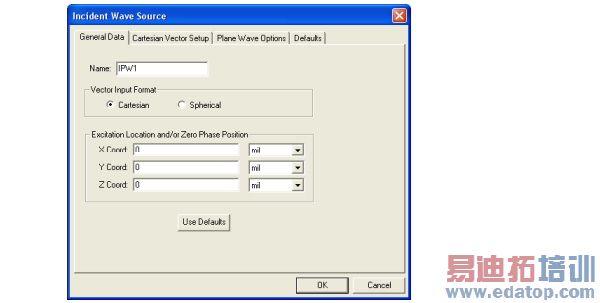- 易迪拓培训,专注于微波、射频、天线设计工程师的培养
HFSS15: Incident Linear Antenna Wave
An incident linear antenna wave is a wave that simulates the far field of a linear antenna placed at the origin.
1. Click HFSS>Excitations>Assign>Incident Wave>Linear Antenna Wave.
You see either the Incident Wave Source wizard or the General tab.

2. Select the Vector Input Format as Cartesian or Spherical coordinates.
3. Enter the X-, Y-, and Z-coordinates of the Excitation Location and/or Zero Phase Position (the origin for the incident wave).
4. Click Next.
5. If you selected Cartesian, the Incident Wave Source: Cartesian Vector Setup page appears. Enter the X-, Y-, and Z-components for the I Vector in the X, Y, and Z boxes. I is the antenna current amplitude (peak value). Units are Amps (A).
A single incident wave will be defined. Continue with Step 8 below.
6. If you selected Spherical, the Incident Wave Source: Spherical Vector Setup page appears.
a. Under IWavePhi, enter Start and Stop points and the number of sweep Points.:
Click View Point List to see the values of f.
b. Under IWaveTheta, enter values for Start, Stop, and Points.
Click View Point List to see the values of q.
c. Enter the f and q components of the I Vector in the Phi and Theta boxes. I is the antenna current amplitude (peak value). Units are Amps (A).
A spherical grid is created when q is swept through each f point. At each grid point, an incident wave is present traveling towards the origin of the coordinate system for the design. The number of incident waves and grid points can be calculated by multiplying the number of f points by the q points.
Note | Only a single incident wave angle can be defined for periodic structures which are defined with master and slave boundaries |
7. Click Next. The Incident Wave Source: Linear Antenna Wave Options page appears.
8. Select the Length of the Antenna.
9. Select the Radius of Surrounding Cylinder. Inside this cylinder, the field magnitude will be made equal to the field magnitude calculated on the surface of the cylinder.
10. To restore the defaults (10 mm), click the Use Defaults button.
11. Click Finish.The incident wave you defined is added to the Excitations list in the Project.
HFSS 学习培训课程套装,专家讲解,视频教学,帮助您全面系统地学习掌握HFSS
上一篇:Installation of ANSYS EM Tools on SGE
下一篇:Inserting an HFSS Design


